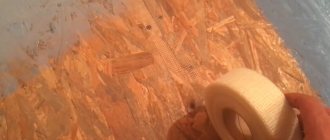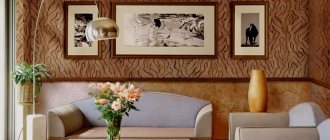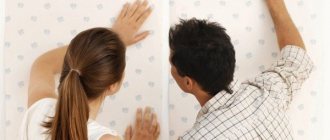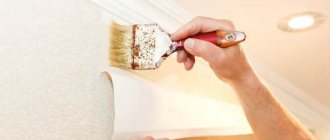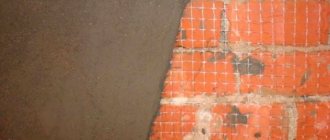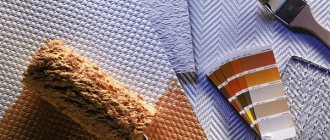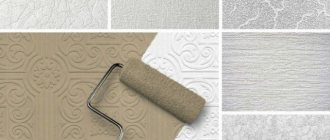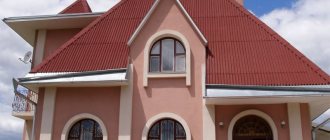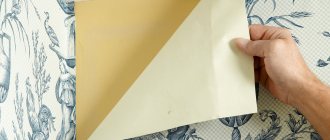Any room will become more comfortable if it is properly wallpapered without distortions or obvious seams. Not everyone can cope with this task. Textile wallpaper is an expensive finishing material. It is made from natural fabrics. Gluing such material requires special skills. Usually specialists are invited for this work. They charge a lot of money for this finishing. In fact, there is nothing complicated here. Let's look at how to properly glue textile wallpaper to get a good result.
Varieties
Hanging textile wallpaper is a labor-intensive and meticulous process. Particular attention should be paid to the choice of fabric wallpaper. There are several types:
- seamless;
- roll;
- prefabricated (consist of separate parts of the panel).
These materials are radically different from each other. When choosing a finishing material for walls, you need to be guided by the parameters of the room. Make sure that the wallpaper color you choose will fit well into the overall design of the room.
Before purchasing textile wallpaper, determine on what basis it is made. This aspect determines what kind of glue the fabric will be treated with. It is divided into 3 types:
- paper based;
- non-woven base;
- based on NON-WOVEN.
In this case, the factory roll of wallpaper is 10 meters long. This is the simplest and most economical option. In some cases, you can order rolls from the manufacturer. The length of one canvas reaches 40 meters.
Selection of materials
When purchasing fabric-based wallpaper, you should take into account several nuances. They can be composed of panels, and also come seamless and in rolls. The first type of wallpaper is the most expensive. Seamless ones are easier to work with, while rolled ones are made on various bases: NON-WOVEN, non-woven fabric, paper.
Fabric wallpaper for walls is best glued to SEM-MURALE - a special adhesive for working with textile wallpaper. There are other compositions for textiles; ideally, buy wallpaper and glue from the same manufacturer. This guarantees the greatest strength of the connection.
Advantages and disadvantages of textile wallpaper
Before purchasing wallpaper, it is recommended to weigh the pros and cons. After all, the result depends on your choice. Incorrectly selected wall finishes may peel off or tear. As a result, the repairs will have to start all over again.
Flaws:
- As a result of incorrect factory production, vertical displacement of the pattern is observed in the rolls. The width of the image merge is different for each manufacturer. Usually this is 1.5–2.5 cm per linear meter of material.
- When purchasing textile wallpaper, the width of the roll may not match the parameters specified in the catalog.
- Excessive moisture or adhesive may cause the fabric material to become deformed.
- For textile wallpaper, use only highly specialized glue. Otherwise, the material may dry out on the wall surface, forming air pockets.
- They require special care.
Advantages:
- Fabric-based facing material dries much faster than other analogues.
- There is no need to soak it with paste before fixing it to the wall. In this case, the wallpaper will still stick quite firmly.
- Lining made from natural fabrics allows air to pass through better
- With skillful drying, the material does not peel off or deform.
Types of fabric wallpaper
Textile wallpaper consists of 2 layers: the front surface and the base. The front surface is made of fabric: linen, viscose, felt, jute, silk, velor, cotton or composite materials. The basis is:
- Paper is an environmentally friendly option, but under the influence of glue, the paper gets wet and may shrink in the future.
- Non-woven - a base made of cellulose and chemical fibers. It is easier to glue such fabrics - they do not swell under the influence of glue and do not shrink.
- Synthetic - foam base. It provides good heat and sound insulation properties, but difficulties may arise when gluing such material.
The width of textile fabrics for wall decoration is selected depending on the tasks. Narrow stripes (50 cm wide) are optimal for creating a decorative panel, highlighting the composition of a room, or gluing one fragment. Wide stripes (up to 3.1 m wide) allow you to create a feeling of limitless fabric surface in the room.
Surface preparation
Preparing the wall surface is one of the most important stages. After all, it depends on how long the wallpaper will look beautiful. As a rule, preparation begins with the removal of old facing materials. If some areas are firmly stuck to the glue, it is recommended to soak them with water.
Old layers must be removed very carefully. As a result, you need to achieve a perfectly smooth and even surface. Even small particles of plaster or old finishing can cause unevenness or tears in textile wallpaper.
After cleaning the walls, they need to be washed. A blow gun is used for this. We fill all the depressions and irregularities with plaster. The last stage of preparatory work is priming with a deep penetration solution. Using a roller, apply the mixture to the wall surface in 2-3 layers. It is recommended to use a primer solution that contains absorbent elements. This will protect your walls from fungus and moisture.
Removing old paint
To effectively deal with old paint, it is necessary to use chemicals. Apply trisodium phosphate to the surface of the dried stain. We wait 20–30 minutes, and any paint is removed using a construction spatula. It is important that if you work with chemical solutions, take care of your safety.
Leveling the surface
After removing the old cladding, dents or depressions may form on the walls. To cope with this problem, we clean the deformed surface from dust and debris and prime it. After drying, fill the cracks with putty and wait for it to dry. At the end, apply another layer of primer and cover all damaged areas with emulsion paint.
Sometimes glue may not stick to emulsion paint. For this purpose, special paper pads are used. They should only be placed vertically to avoid joints on the wallpaper.
Preparation of tools and materials
Before gluing textile wallpaper
, additionally prepare:
- gypsum putty;
- a primer that penetrates deeply into the surface;
- oil emulsion paint that matches the tone of the selected wallpaper;
- roulette;
- a simple pencil;
- sharp scissors;
- glue for fabric wallpaper (high quality, without dyes);
- a tray for it;
- short-hair roller for applying adhesive composition;
- rubber roller;
- plastic spatula;
- foam sponge;
- strips of wax paper 2 mm thick;
- construction knife.
How to stick
Fabric wallpaper should always be applied from a corner, observing the direction of the pattern on the surface. In order not to get confused in this process, the walls are covered with markings. It is important that each canvas is glued only end-to-end. There are no other options for this species.
Before fixing the first part, a gap of 3–4 cm is left. The base is pressed against the wall surface only with the help of a rubber roller. Movements should be smooth and slow. Gradually work your way down to remove excess air.
Pasting process
Impregnation of wallpaper for better adhesion
If the adhesive composition is thin, it is necessary to impregnate the wallpaper. Usually the manufacturer immediately notifies you about this on the packaging and gives instructions on how to do it correctly.
Apply to the wall from the corner a layer of glue necessary to glue one piece. A section is carefully placed from the top corner so as to maintain the horizontal and vertical nature of its texture. All further work depends on the first canvas. Then the canvas is smoothly smoothed along a plumb line and pressed against the wall with a medium plastic spatula. Rollers cannot be used for this. Make sure that the edge of the segment coincides with the previously applied markings on the wall.
Canvases can only be glued from top to bottom, without overlapping, butt-to-butt. Smoothing wallpaper with rags, rollers or hands is prohibited. Try not to let the glue get on the front side of the canvas - the surface will instantly deteriorate and cannot be restored.
Gluing fabric wallpaper onto walls is done very carefully. Wrinkling and smoothing in directions other than top to bottom should be avoided. When folds form, it is simply impossible to stick the canvas evenly.
The best adhesives for vinyl wallpaper without an indicator
Such adhesives are suitable for most vinyl wallpapers - both heavy and light. They are cheaper than compositions with indicators, but in terms of adhesive ability they are no different from them.
Quality De Luxe “Vinyl” – super tenacious adhesive
4.9
★★★★★
editorial assessment
90%
buyers recommend this product
Quality De Luxe will stick to even the heaviest vinyl. It can be used in rooms with high humidity, and can also be used for wallpaper made from natural materials.
For its production, exclusively natural components are used: modified starch and special additives that ensure the most reliable adhesion of the canvas to the wall.
Advantages:
- Highest quality;
- Perfect adhesion;
- Can be used for luxury and heavy wallpaper;
- A pack is enough for 7-10 rolls;
- Can be applied directly to the wall.
Flaws:
- Not sold in all stores yet.
Quality De Luxe is suitable for exclusive, expensive wallpaper that needs to be treated with the utmost care. With this glue you can even glue textiles to walls.
Semin Sem Vinyl – durable adhesive
4.8
★★★★★
editorial assessment
89%
buyers recommend this product
When dissolved in water, Semin Sem dry glue becomes gel-like, so it applies well and glides perfectly. It securely adheres the finish to the base for the entire life of the vinyl wallpaper.
It contains bactericidal substances and modified starch. A pack of glue takes 4 liters of water - this is enough to glue 5 rolls of wallpaper.
Advantages:
- Safe for others;
- Prevents the spread of mold and mildew;
- Sealed packaging;
- Easily washed off from tools with plain water.
Flaws:
- High price.
This wallpaper adhesive is suitable for all types of vinyl wallpaper, regardless of its base.
Quelyd Aqua “Vinyl” – for kitchen and bathroom
4.7
★★★★★
editorial assessment
87%
buyers recommend this product
Moisture-resistant glue with antiseptic additives does not clump and is used quite economically - a pack is enough for 6 rolls. Moreover, the product is suitable even for heavy wallpaper.
The glued sheets can then be easily washed using suitable products - this will not affect the adhesive layer in any way.
Quelyd Aqua is absolutely safe for people, animals and the environment. In dry form, it is flakes based on modified starch.
Advantages:
- Moisture resistance;
- Environmental friendliness;
- Glides well, allowing you to adjust the wallpaper;
- Easy to use.
Flaws:
- Cooking time takes 15 minutes.
Quelyd Aqua is perfect for gluing any vinyl wallpaper (including washable ones) in rooms with high humidity.
Lakra “Vinyl” – adhesive for heavy and structural wallpaper
4.6
★★★★★
editorial assessment
86%
buyers recommend this product
This composition contains an antiseptic that prevents the development of mold and fungi, and the base is modified starch.
Ideal composition for use in damp areas such as the kitchen or bathroom. One pack of 300 g is enough to glue 7-8 rolls. The composition does not change the color of the wallpaper and dries quickly, holding the canvas securely on the wall.
Advantages:
- Quick cooking;
- Easy application;
- Possibility of adjusting the position of the canvas on the wall;
- Reliable fixation;
- Acceptable price.
Flaws:
- Consumption is slightly higher than indicated by the manufacturer.
Lakra glue can handle any wallpaper, even very heavy ones, without staining or stretching it.
Axton Vinyl Adhesive - Instant Adhesion
4.5
★★★★★
editorial assessment
85%
buyers recommend this product
The Axton composition is suitable for any type of vinyl wallpaper, including multi-layer heavy canvases. One pack of 230 g requires 6 liters of water, and the finished solution is enough to stick on 5 to 7 rolls.
The mass is prepared in exactly 5 minutes. Its thickness and consistency allows you to effortlessly adjust the wallpaper to the wall before gluing it completely.
Advantages:
- Good adhesiveness;
- Low consumption;
- Easy to apply;
- Does not form lumps;
- It can be stored diluted for about a week.
Flaws:
- The glue is poured directly into the cardboard box - without a sealed bag.
Axton offers the best value for money. The product is effective and economical, but when purchasing, it is better to make sure that the mixture was stored correctly and that it did not stick together in lumps right in the box.
READ ALSO
13 best series of ceramic tiles
Aspects
It's time to discuss the technical side of things. The following tools will be useful for gluing:
- plaster spatula;
- water-based paint;
- a piece of soft fabric;
- rubber roller;
- short pile roller;
- glue for textile wallpaper;
- scissors.
Important! It is necessary to use a specialized type of glue.
How to care for wallpaper
Caring for them, as well as the process of gluing them, requires care, which will increase their service life. They are intended for dry cleaning only. Use the same vacuum cleaner to remove layers of dust from them. There are special stain removers for textiles. They can be used in extreme cases of serious contamination in hard-to-reach places.
Caring for textile wallpaper requires dry cleaning only.
You can also use clear varnish to cover your walls. In general, look carefully at the packaging of the rolls; all the properties they have are indicated there. Rare options even include wet cleaning.
But the main disadvantage is that they instantly absorb all moisture and all odors, so it is highly not recommended to use them for gluing the walls of a bathroom or kitchen. In addition, they are quite expensive to constantly replace due to stubborn stains that appear.
The best adhesives for vinyl wallpaper with indicator
A special feature of this glue is the presence of a colored pigment, which allows you to control the quality of application of the composition to the canvas.
When the composition is diluted, its color becomes pink, which helps to coat the strip of wallpaper without gaps.
A few minutes after application the pigment becomes discolored. It does not leave stains and does not stain the material. For professionals, using glue with an indicator is an extra expense.
Methylane "Vinyl Premium" - high-quality waterproof adhesive
4.9
★★★★★
editorial assessment
96%
buyers recommend this product
See review▶
This glue can be used to glue any vinyl and paper wallpaper, as well as silk-screen printing. The color indicator allows you to apply the composition as evenly as possible, but after drying it becomes discolored and does not leave any traces. Preparation of the solution takes 3 minutes. The composition contains antifungal components.
Advantages:
- Strong adhesion;
- Can be used in damp areas;
- When diluted, it can be stored for 10 days;
- High quality;
- Ease of use.
Flaws:
- High price.
Methylane is a high-quality adhesive for light and heavy wallpaper, which can be used when renovating kitchens and bathrooms.
Moment “Indicator” (300 g) – quickly and efficiently
4.9
★★★★★
editorial assessment
90%
buyers recommend this product
See review▶
This glue is of high quality and the ability to control application. It is suitable for vinyl wallpaper, silk-screen printing and foam vinyl.
The application mixture is prepared in just 3 minutes. It also contains antifungal components. Remains of the product are removed with a cloth soaked in plain water.
Advantages:
- Easy correction of joints;
- No lumps;
- The indicator becomes discolored when dry;
- Eliminates the appearance of fungus under the wallpaper;
- Once prepared, it can be stored for 10 days.
Flaws:
- It is not used sparingly.
Moment adhesive is suitable for any vinyl, leaves no marks and holds wallpaper perfectly.
Tytan Euro-Line “Vinyl” – waterproof, economical adhesive
4.8
★★★★★
editorial assessment
88%
buyers recommend this product
German starch-based glue contains an antiseptic and antifungal agent. It is easy to apply thanks to a light pink indicator that discolors as it dries.
It takes 5 minutes for the powder to completely dissolve. 250 grams of glue is enough to glue at least 7 rolls. Drying time – 24-48 hours.
Advantages:
- Fast dissolution;
- Economical consumption;
- Gel structure and easy glide;
- When diluted, it can be stored for up to 3 weeks;
- Excellent water resistance;
- Eliminates the appearance of mold under the wallpaper.
Flaws:
- It takes a long time to dry.
This glue is suitable for any type and size of vinyl wallpaper, but for thin sheets it is better to take something simpler.
Kleo Smart “Vinyl with indicator” – sticks everything
4.7
★★★★★
editorial assessment
87%
buyers recommend this product
Glue based on modified starch is prepared in 7 minutes. It is designed for vinyl and paper wallpaper, being an absolute all-rounder.
The composition glides well, so you can adjust the design directly on the wall. Its formula is safe for animals and children, and a 200-gram package is enough for 7-9 rolls.
Advantages:
- Fast dilution without lumps;
- The packaging is protected from moisture;
- Wallpaper can be easily adjusted when pasted;
- Antifungal components in the composition;
- Can be stored diluted for 10 days.
Flaws:
- The actual consumption is always more than indicated on the packaging.
The high-quality composition of Kleo Smart will stick even the most capricious wallpaper.
Pufas GT Vinyl Indikator – safe adhesive with lemon scent
4.5
★★★★★
editorial assessment
85%
buyers recommend this product
Pufas GT Vinyl is designed for all types of vinyl wallpaper and has a pleasant lemon scent. When applied, the indicator turns pink and dries transparent.
The basis of the raw material is starch-containing ether. Acidity – 8-9 pH. It takes 5 minutes to prepare the glue. One package (225 grams) is enough for 7-9 rolls.
Advantages:
- Easy application;
- Pleasant aroma;
- Applicable to all heavy wallpapers;
- Quick cooking.
Flaws:
- Lumps may form when stirring.
Thanks to a clearly visible indicator, Pufas glue allows you to completely paint over the canvas. The only thing is that when dissolving the dry concentrate, you will have to work hard to get rid of lumps.
READ ALSO
11 Best Bathroom Sealants
What to remember when working with glue
Choosing the right wallpaper glue is half the battle. It is important not to make mistakes when working with it. To prevent the wallpaper from falling off immediately after gluing, you need to remember the following points:
- Prepare the walls carefully. The surface must be cleaned of old finishes, and cracks and defects must be filled with putty, sanded and covered with primer.
- Dilute the glue strictly according to the instructions. The water can be cold or warm, but it must be clean. The material is added to the liquid little by little, without ceasing to stir, to avoid the formation of lumps. The mixture is left for some time until the flakes dissolve and the consistency becomes homogeneous.
- Apply the material from the center to the edges with a special brush or roller in a thin layer. It is convenient when the adhesive composition contains a colored additive. Then the unpainted areas are clearly visible.
- Do not throw away the remaining glue. It will be useful for gluing corners.
If you decide to save money, you can make glue from flour and starch. Only in this case you will have to tear the wallpaper off the walls almost with your teeth. It’s easy to avoid such hassle – buy special glue for a certain type of wallpaper. Considering that the stores have quite budget materials, the costs will not be so ruinous.
What is textile wallpaper
Before you begin the pasting procedure, you need to understand what this material is. It consists of two layers, front and inner. The first is fabric, and the second is paper or non-woven.
Various fabrics are used for manufacturing:
- silk and viscose;
- linen and velor;
- bamboo and natural veneer.
Other types can be used, each of which has its own disadvantages and advantages. Velor is most often used due to the fact that its velvety surface gives the most beautiful appearance.
No. 4. Should I take it ready-made or dilute it with water?
Wallpaper glue can be sold in two formats:
- ready-to-apply adhesive;
- powder that must be diluted with water.
to use a ready-made composition , since you don’t have to waste time, even if it’s a little, on studying the instructions for preparing the glue and directly on the preparation itself. Ready-made glue is sold in buckets and costs a little more than dry glue. When purchasing, carefully monitor the expiration date, since the glue can remain in a liquid state for a relatively short time.
Dilute the dry mixture with water - one of the simplest tasks in repair. It is enough to follow the instructions and add a strictly defined amount of water, mix thoroughly and let the glue “simmer” for a while, unless otherwise indicated on the package. In general, just follow the instructions. This type of glue is the most popular.
For beginners, there are glues that are colored blue or pink . This is necessary so that you do not miss a centimeter while wallpapering. After drying, the composition becomes transparent. Such glues cost more than regular ones and are in demand, but not all beginners realize that there is no point in such colored glue. The fact is that when applying regular glue, wallpaper sheets become a little darker, and uncoated areas are easy to determine without any indication.
Wallpaper that already has a layer of glue on it deserves special attention . To activate it, you need to peel off the protective film and/or moisten it a little. There is no need to take a bucket, dilute glue, use rollers and wait for the glue to dry. But self-adhesive wallpaper is more expensive than regular wallpaper and is very thin, so the surface will have to be prepared especially carefully.
